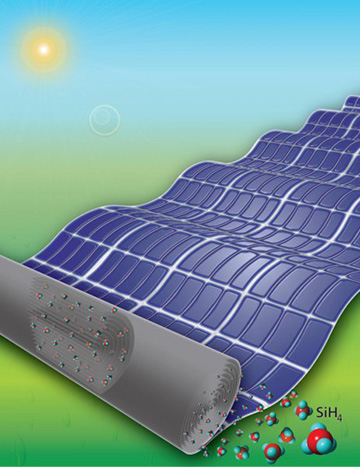
High-pressure deposition inside coiled, flexible substrates allows for large-area, hydrogenated amorphous silicon films. Credit: Penn State University
Pennsylvania State University (USA) researchers led by John Badding say they have demonstrated a new method that could create long, flexible sheets of thin-film hydrogenated amorphous silicon (a-Si:H) in a fraction of the space and at a fraction of the cost of current methods (Adv. Mater., doi: 10.1002/adma.201600415). These films could find applications in large, flat-panel monitors and solar cells.
Weeding out “clumpiness”
Hydrogenated amorphous silicon is a promising candidate for second-generation thin-film solar cells because of its strong optical absorption, abundance and nontoxicity. Current methods for creating thin-film a-Si:H typically begin with silane gas (SiH4), which is difficult to separate into atoms for chemical vapor deposition (CVD).
One way to break silane apart is to create a gas-phase reaction at a low temperature; this is achieved by creating plasma in a large volume of gas at low pressure. This gas-phase reaction can be sped up by increasing pressure, but the added force causes the hydrogen atoms to aerosol out, leaving behind clumpy silicon particles instead of a thin film.
The Badding group says it has discovered a way use a high-pressure environment to speed up CVD, maintain thin-film quality and suppress particle formation. The group’s technique confines CVD to microscale spaces in a closed stainless steel cylindrical chamber under high pressure. Elevated pressure allows for faster deposition rates, and the microscale spaces reduce silicon particle formation.
A hundred meters long, 50 microns thick
The confined spaces also provide extra surface area for film deposition. The authors say that the internal dimensions of their coiled substrate model could be scaled up without increasing reactor size to create films that are meters wide and hundreds of meters long. For example, a coiled cylindrical chamber 15-cm in diameter could create a film 50-µm thick and 100-m long.
Using this high-pressure CVD method, the team was able to achieve deposition rates 100-fold faster than conventional CVD methods. They also demonstrated thin-film quality using scanning electron microscopy and created proof-of-concept solar cells. Badding and his colleagues are working to better understand the details of the high-pressure reaction kinetics and how they relate to film structures and properties.
